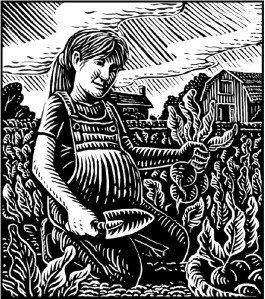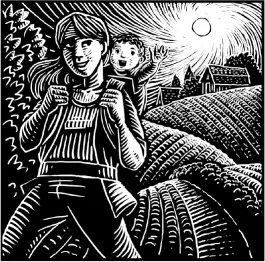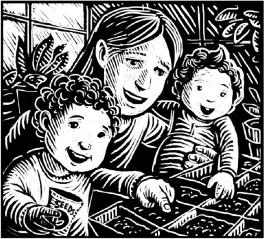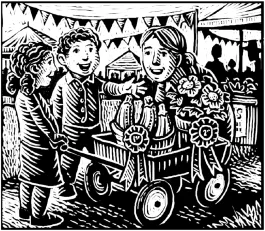 Pregnancy—Keep working outside every day. When feeling nauseated in the Spring, slowly pick and munch on raw kale buds while working and hope it’s nutrition your body needs. When it gets hot in the Summer, work in the morning, but seek shade in the afternoons. Kneeling and leaning forward is good for baby positioning, so kneel to dig potatoes, kneel to bunch beets, kneel to cut lettuce. In the Fall, buy men’s fisherman-style rain bibs and matching jacket, which work well as maternity rain gear. In Winter, prune. Slowly, but keep moving.
Pregnancy—Keep working outside every day. When feeling nauseated in the Spring, slowly pick and munch on raw kale buds while working and hope it’s nutrition your body needs. When it gets hot in the Summer, work in the morning, but seek shade in the afternoons. Kneeling and leaning forward is good for baby positioning, so kneel to dig potatoes, kneel to bunch beets, kneel to cut lettuce. In the Fall, buy men’s fisherman-style rain bibs and matching jacket, which work well as maternity rain gear. In Winter, prune. Slowly, but keep moving.
Birth—You did, of course, time your due date to be right after your final December harvest of the season. (You did, right?) Buy and decorate a small Christmas tree early so that it’s ready before baby arrives. When early labor signs show up during your last vegetable delivery, go directly home and pay the bills. When labor begins at a pace too slow for progress, take slow moaning laps around the frozen fields, holding onto your husband, farming partner, soon-to-be co-parent. As labor continues into the coldest night of the year, settle into the birth tub next to the woodstove. Finally, at midnight, give birth in the dark on your bed, with husband, midwives, and farm cats present.

Newborn—Sit with your new baby. Sit and stare into his eyes. Sit and nurse. Sit and hold his sleeping form. And sit some more. Feel your farmer body, strong from hauling bins full of potatoes and squash, now aching to move and reach and bend and lift something more than ten pounds of baby. Stare at icy fields, at crops damaged by the record-low temperatures, then look tearfully at your husband and wonder aloud whether sitting is all you’ll do for the rest of your life and whether Winter will destroy the farm. Temporarily believe that the present moment is a new reality that will never ever change. Believe you will always be sitting here and it will always be Winter. Mourn for the lost seasons, even as you rejoice in every little detail of your new baby.
Baby—Hire a capable employee to replace your daily hands in the field. Resign yourself to more time inside, more time looking out windows, more time reading about farming than farming itself. But also notice that your baby seems to be calmed by the outdoors. Take every opportunity to walk him around the fields. As Spring arrives, carry him to see the new blossoms on the young apple trees and give him sugar snap peas to teethe on and well-cooked cauliflower as his first foods. Learn that with a baby napping on your back, you can do more again: some farm work, but also plenty of hiking. Build up your leg and back strength, showing your baby forests near the farm. Confidently stride up hills, exultant in your burning lungs.

Toddler—Watch your child learn to walk on the solid but soft ground in your Winter greenhouses: a tiny little figure in tiny overalls staggering from kale plant to kale plant. In Spring watch his confidence grow, taking him farther into the field, especially to the strawberries and peas where he learns that sustenance is the gift of the earth and that he is already capable of harvesting and feeding himself. Watch him make up his own dance to the rhythm of the irrigation sprinklers, yelling in wordless delight that such treasures exist. Experience more of the farm from his low height. Be grateful that you farm organically as the soil itself becomes a friend and toy for this growing human. Trade vegetables for babysitting time so that you can have a few hours a week to work without constantly glancing at a small human, assessing his safety and/or contentment minute-by-minute. Use some precious naptime to get pregnant with baby #2.
Preschooler—With a preschooler and baby in the house, give up all hope for productivity. Know this time around that it will in fact be temporary.

Kindergartener—Invite your growing children to help you do some basic farm tasks. Teach them how to sow seeds in trays and even how to transplant and weed and cut salad mix. Teach them how to safely handle knives and how to carefully tamp plants into the freshly tilled earth. When their interest wanes faster than the workload, bring out buckets with plastic animal toys and shovels. (For the next billion years, regularly unearth plastic animals from the fields when tilling.) To provide more ease in combining kid play and farm work, tear apart a harvest wagon and repurpose it with a small playhouse on top. Pull the playhouse around the fields so that the children can play nearby as you work. Get some work done, but also always respond quickly to children who “have to go poop.” Sit by the toilet as they go, feeling minutes tick by slowly as the weeding waits in the fields.

Grade School—Provide your children their own small garden plot and help them pick seeds, sow, and weed. Help them enter their produce and flowers in the very small county fair. Hang their blue and red ribbons on the walls of their room. Provide them with shovels and a place to dig giant holes that turn into forts and a world all their own at the edge of the fields. Invite them to continue helping with the planting, weeding, and harvesting for the farm, but be OK with only sporadic involvement. Spend more time in the field yourself, kneeling again to dig potatoes and bunch kale. Buy walkie-talkies so the children can read and play at the house and still stay in touch. Answer their radio questions such as, “How do you spell ‘squirrel’?” Note how much taller they are next to the pea trellis each new Spring, how much higher they can reach into the apple trees—the farming seasons cycling around and marking another year of their growth.
Marvel at their growing independence. And your own. ❖
This article was published originally in 2022, in GreenPrints Issue #128.



